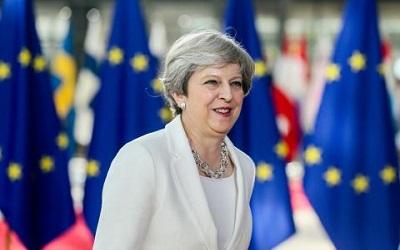Day 187, Year of #Mygration: Chequers plan and the Irish border

In our final article this week, Simon Usherwood, a Reader in Politics at the University of Surrey, looks at the "Chequers plan" and argues why Theresa May’s Brexit blueprint is not quite dead. This article was originally published in The Conversation.
The informal meeting of EU leaders in Salzburg on September 19 and 20 was not intended to be primarily about the UK or Brexit. The EU faces serious challenges around internal security and migration that come much higher up the list of priorities for most member states.
And yet the Salzburg meeting has become the most prominent nail in the coffin of Theresa May’s “Chequers plan” for the future relationship between the EU and UK.
That plan, thrashed out in July, was an attempt to find a common position that cabinet ministers and the Conservative party could rally around as the formal negotiations on leaving the EU moved into their final stages.
In essence, it proposed making a “common rulebook” for goods between the UK and EU, some shared customs arrangements and a joint institutional framework to manage relations. This was seen as a way to avoid the need for border controls between Northern Ireland and Ireland, reduce the role of the European Court of Justice in the UK and allow for an independent trade policy.
Unfortunately for May, the success in getting this to the table and having it signed off was an almost immediate barrage of criticism.
First, the resignations of the Brexit secretary, David Davis, and foreign minister, Boris Johnson – two key figures in the Brexit process – highlighted the extent to which there was division within her senior team. Second, assorted backbench MPs indicated their unhappiness with the text, something that has continued unrelentingly ever since. And finally, the EU’s reaction has been equally consistent, albeit dressed in ambivalence rather than disgust.
Repeatedly through the summer and early autumn, EU officials, from chief negotiator Michel Barnier down, have expressed concern that the Chequers plan did not work with the needs of the EU. In particular, the apparent attempt to split up the four freedoms of movement that make up the single market never looked acceptable.
So what’s changed?
To a considerable extent, the European Council president, Donald Tusk, has been a friend of the UK in the negotiations, working to find common ground and smoothing over some of the differences.
This makes his comments at the Salzburg press conference – to the effect that “the suggested framework for economic cooperation will not work” and that the UK has to make substantial movement on its position in time for the October European Council – mark a very hard blow to May’s plans.
The least worst option
All of which might indicate that Chequers is as dead as the Monty Python parrot: disliked and disavowed on all sides, both home and abroad.
And yet, May has fought on with it. In her own press conference, straight after Tusk’s, she defended her proposals and gave no quarter to the criticisms that had been thrown at her. Given that she is more than aware of the pressure she’s under to change policy, there has to be some reason for not buckling.
The EU, meanwhile, has been unwavering in its insistence on an Irish backstop that protects the existing border arrangements in Ireland. Chequers was at least an effort to square that circle.
Three options present themselves.
First, the criticisms of Chequers come from different directions and push towards different solutions. Tory backbench pressure is towards a much more distant trading relationship. The EU, meanwhile, has been unwavering in its insistence on an Irish backstop that protects the existing border arrangements in Ireland. Chequers was at least an effort to square that circle. Any alternative might be even less acceptable to one or more parties.
Put differently, the problems with Chequers might be smaller than the problems of any other plan. May might seek to use that to get some movement from others as they see that this is the least worst option. Alternatively, May’s defence might be built on the position that no one else has come up with an alternative.
Second, the failure of the European Research Group of MPs, who favour a hard Brexit, to produce a full plan shows how it is easier to criticise than to find other options. And it’s a truism of negotiating that setting the agenda is a really good way of getting more of what you want.
Echoes of this certainly ran through May’s comments, when she invited others to come up with something more acceptable. But then the EU has repeatedly made it clear that it sees this as a matter entirely of the UK’s own making. Nonetheless, given the intensity of political attention on both sides of the negotiating table on getting a deal signed and sealed on Brexit, it is perhaps this third option that looks most likely.
Quite simply, Salzburg was a step in a process, albeit not quite the step that had been anticipated, and Chequers will evolve as part of that.
May is sharply constrained domestically on Brexit, both in her party and in parliament. Part of that has been a need to avoid collapsing her party’s support, especially in the run up to the approaching Conservative party conference. Once through that, she potentially has more space to make concessions.
In her comments in Salzburg, May spoke of bringing new proposals forward, albeit with no detail on these, and this might be the way forward that she is latching on to. But her trip to Austria has made it even harder to argue that Chequers is really the answer to the Brexit question.
Read the original article by Simon Usherwood in The Conversation
Quarterly Review of Research
Read our Quarterly Review of Research to learn about our latest quality academic output.

Contact our news team
For all out of hours enquiries, please telephone +44 (0)7901 515891
Contact detailsNews & articles

Research image of the month - flood resilience, community voices, and a panoramic perspective
This month’s research image of the month (June 2025) encapsulates Claude Nsobya’s research on how communities are leading the way in managing flood risk through local knowledge and natural solutions.